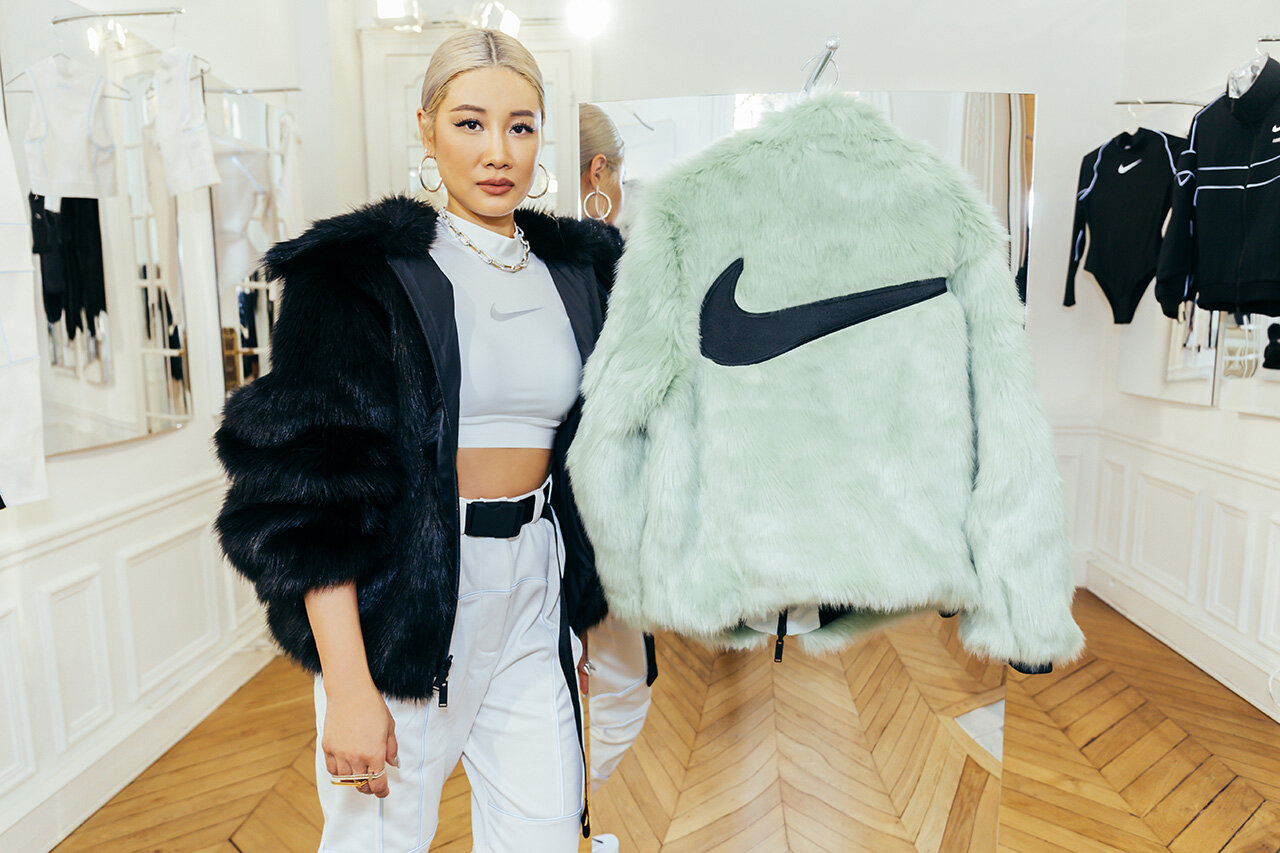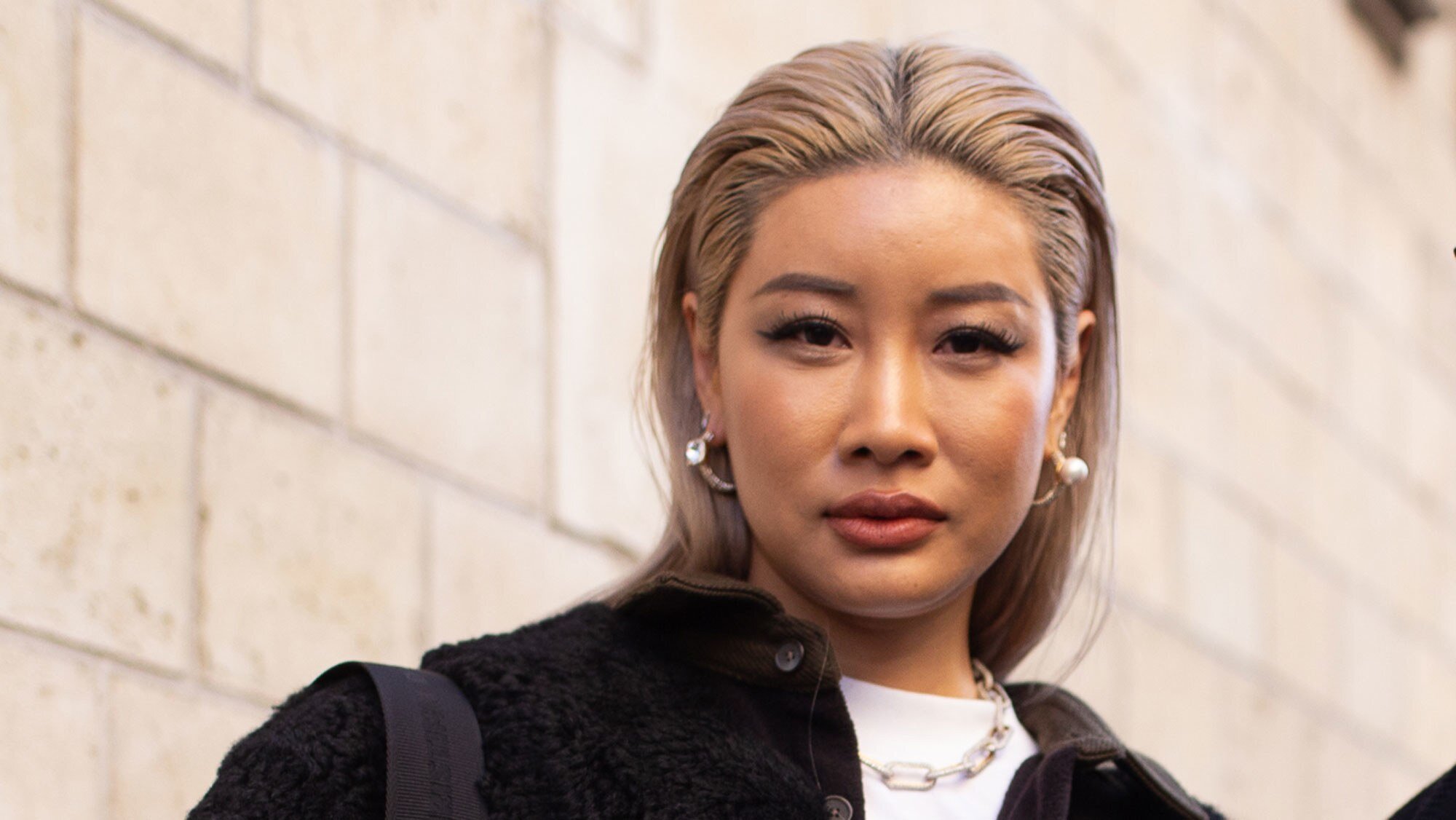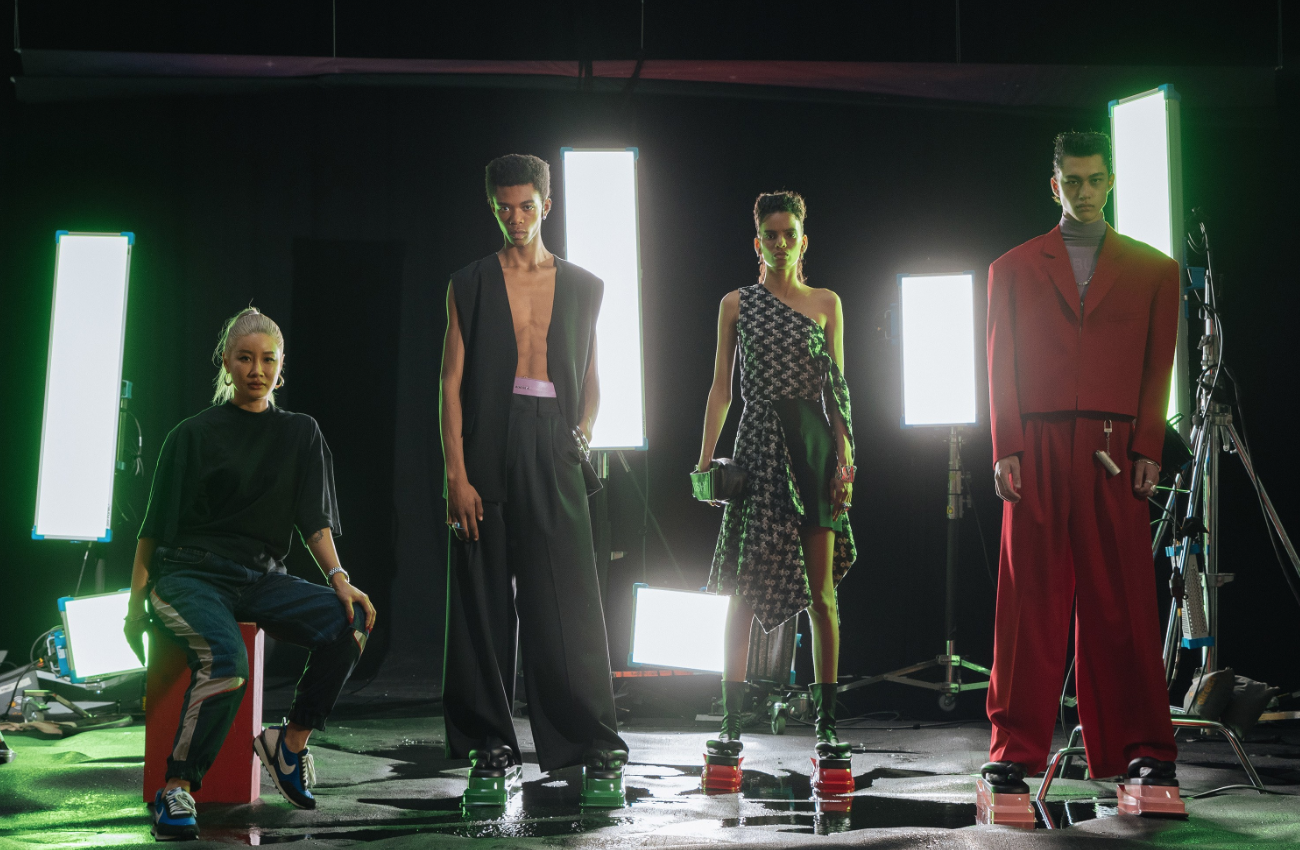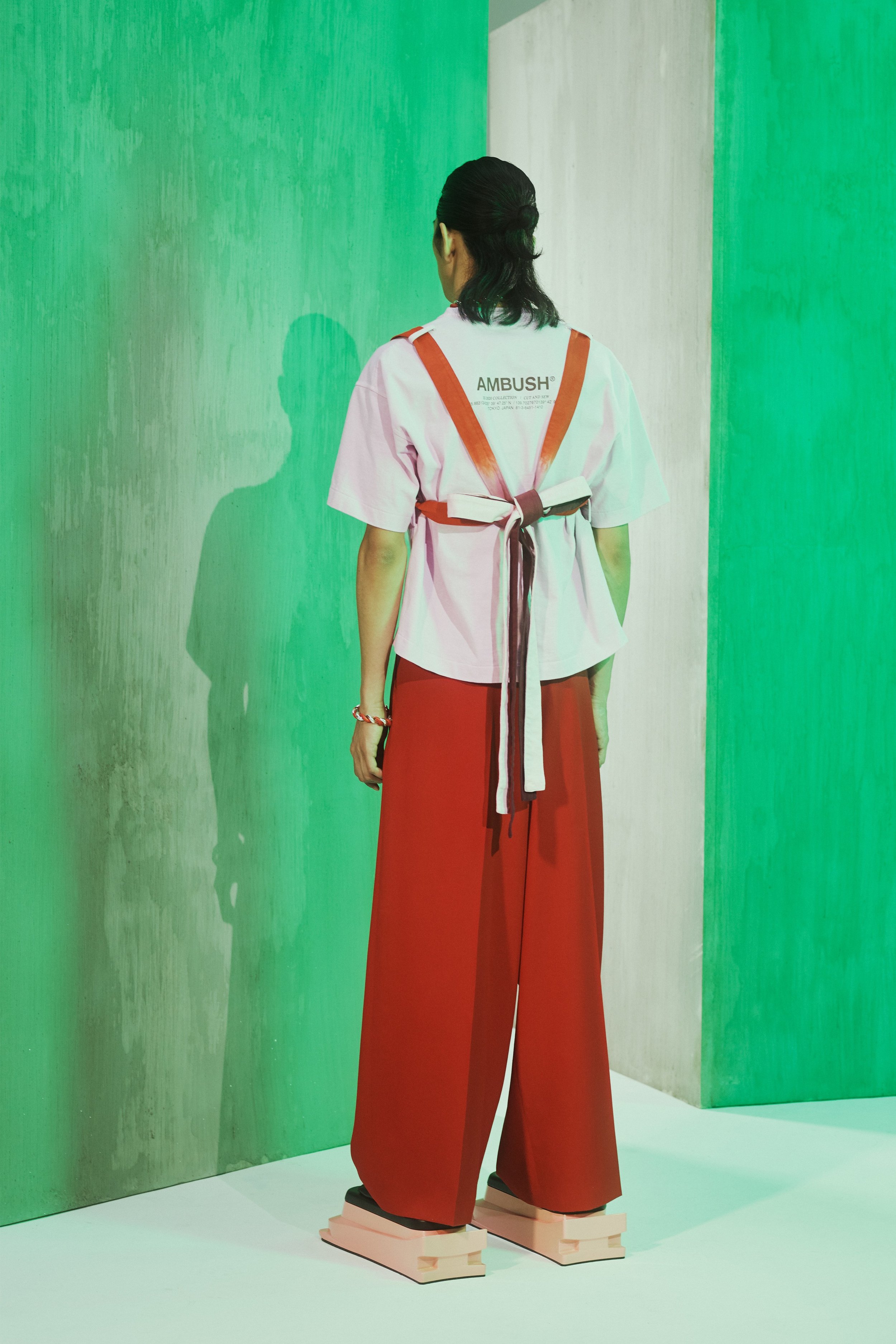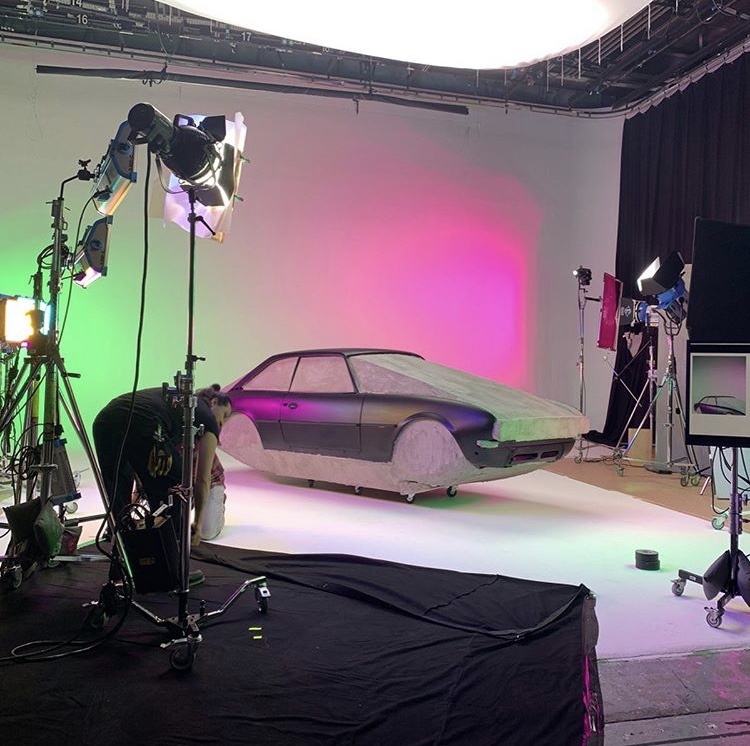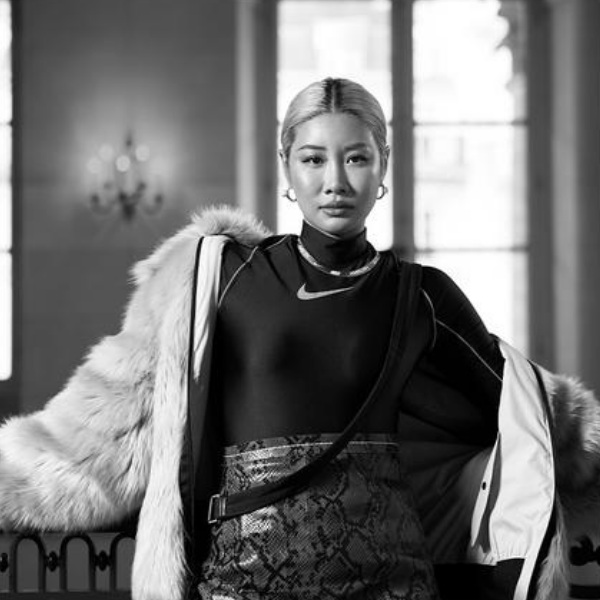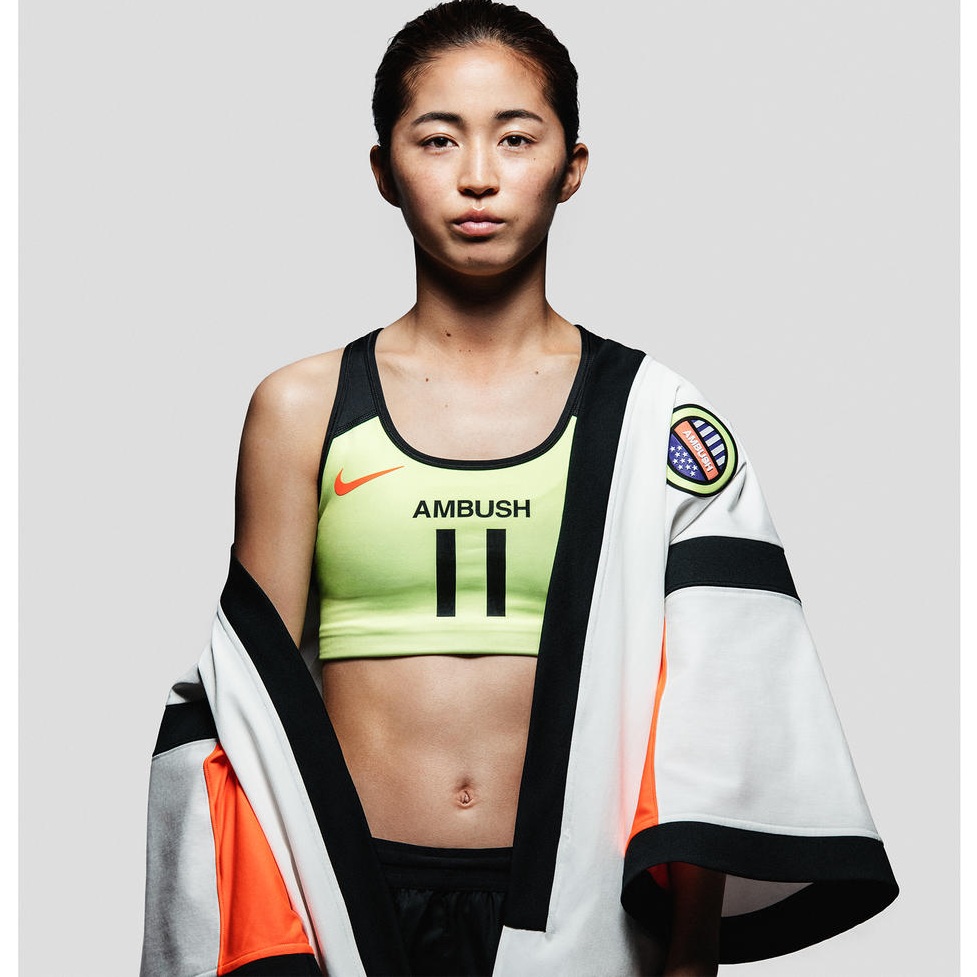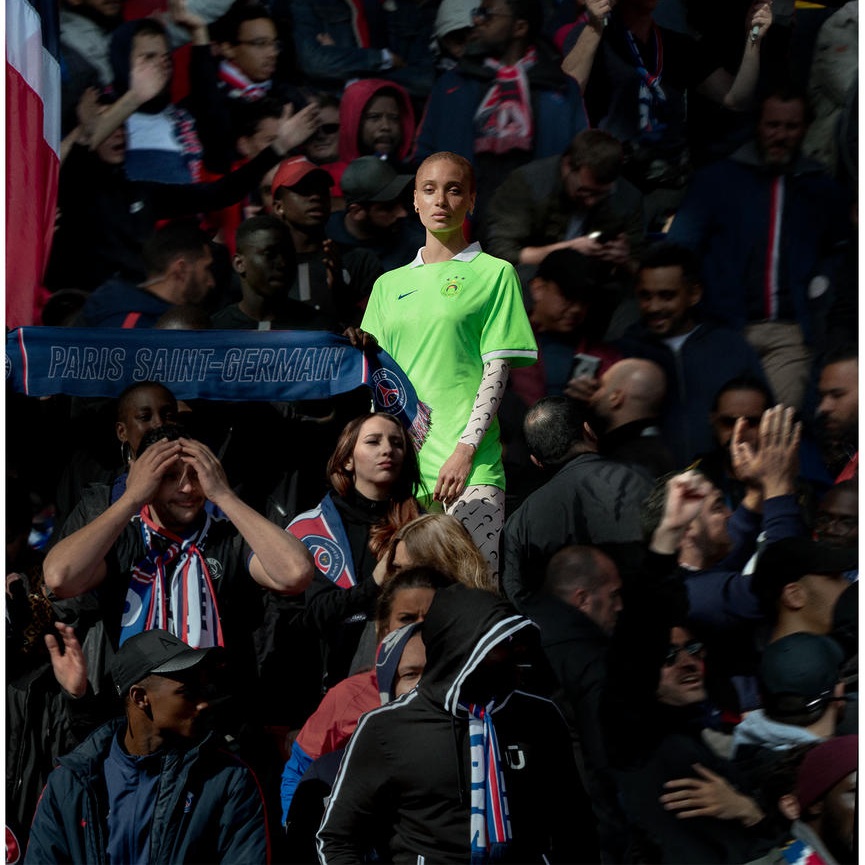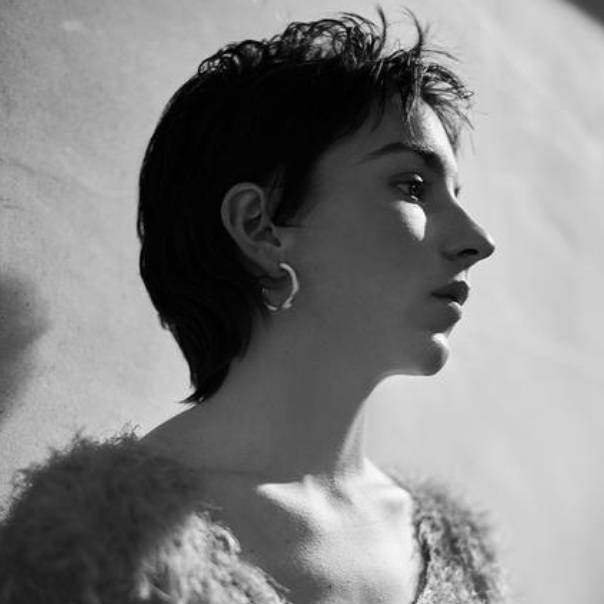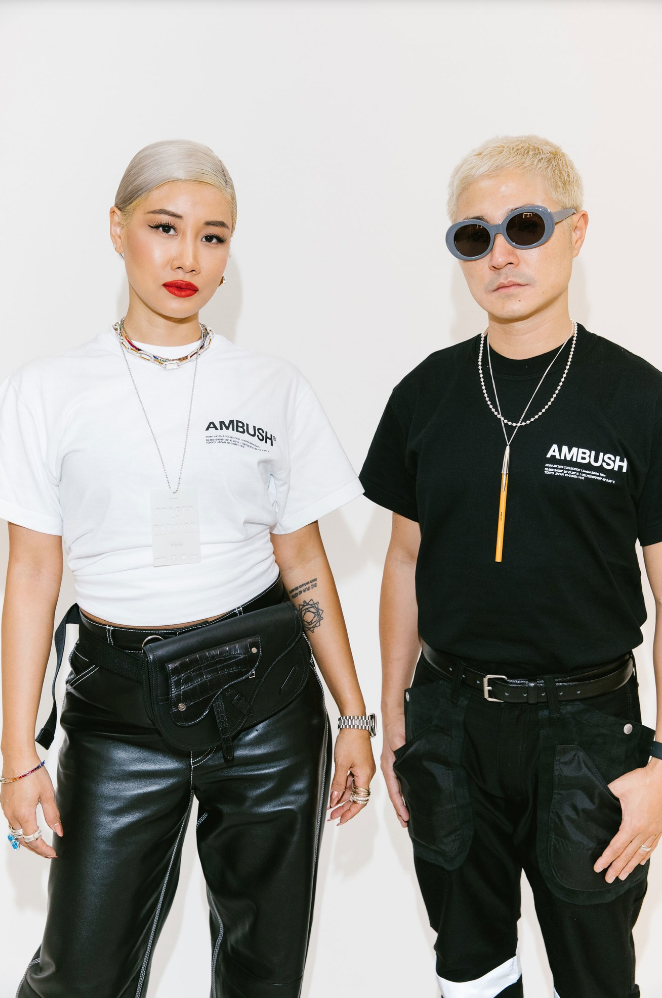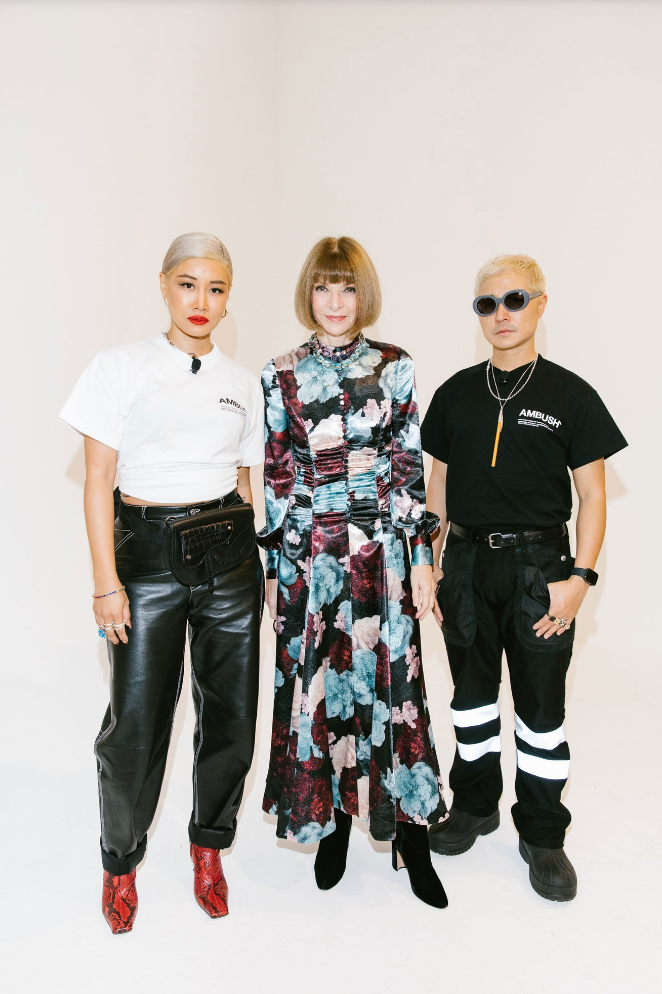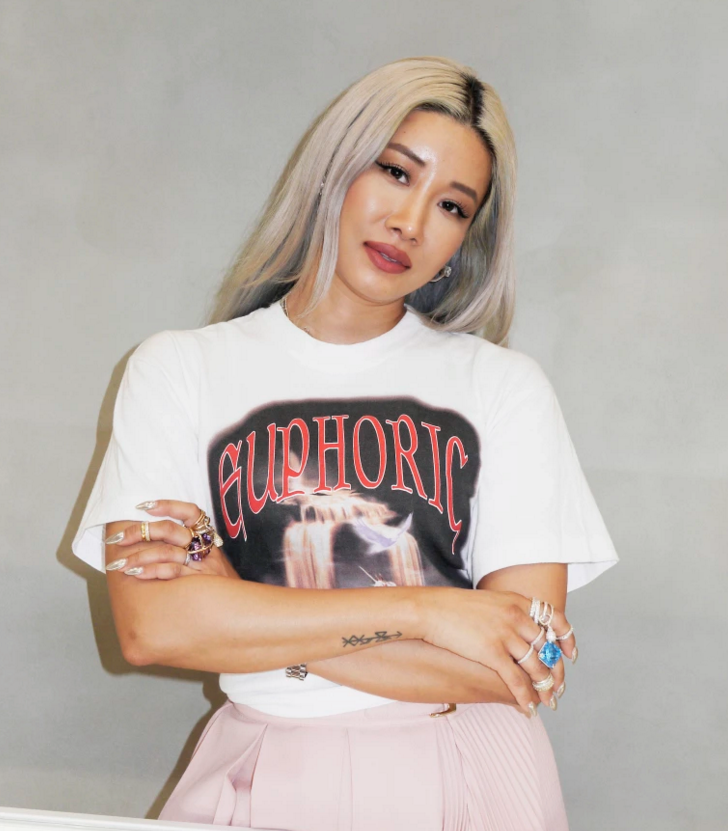By Christopher Morency for Highsnobiety
AMBUSH
Elle Magazine: Yoon Ahn Is Suddenly Everywhere Right Now /
By Veronique Hyland for Elle Magazine
Some fashion designers want to talk to you about the Michelin-starred caviar restaurant they just tried, or the vacation destination that has a yearlong guest backlog—you know, the one they just jetted back from? Yoon Ahn wants to talk about robotics. “Those guys, Boston Dynamics, that build robots?” she says, as if that will elicit some glimmer of recognition from me, her far-from-robot-fluent interlocutor. “I’ve been obsessing over them. They were trying to build this robot with new technologies, but I guess it wasn’t working out. So they went back to nature, and they started implementing things they were finding in insects and animals.” For Ahn, it represented a realisation that technology has its limits. “It made me think, ‘All the answers that we need already exist on this planet, right? The more technology that’s developed—how are we going to make it more human?’”
This turn in the conversation is as unexpected as a robot suddenly gaining sentience, but the detour comes about because we’re talking about the fall 2019 collection for her line, Ambush. The clothes have a futurist-meets-survivalist bent—ripstop nylon, quilted vests, cargo pants, carabiner clips worn as earrings—kind of like the outfit you’d wear to go on a hike in 2035. The initial concept came from a viewing of the David Bowie film The Man Who Fell to Earth, which she understatedly describes as “a weird movie.” The conceit is that Bowie, perfectly cast as an alien, comes to Earth when his planet runs out of water.
“But he ends up getting involved in earthly bad things, like alcohol and sex and drugs, so he never goes back,”
she summarises. For Ahn, a collection often starts with this kind of pop culture–assisted push. Some designers, she says,
“physically go to places to get inspired. I wish I could do that, but I don’t really have the time, so when I get obsessed with certain artists or certain movies, I try to draw ideas from those places. Also, I’m a city girl, so I look at those things as my mental escape.”
In fact, the Korean-born Ahn calls two cities home, splitting her time between Tokyo and Paris, where she works as the design director of jewellery for Dior Men. Despite the fact that she’s sidewalk-bound, she has an affinity for nature, perhaps because she spent part of her formative years in the Pacific Northwest (she relocated to Tokyo in 2003). She thinks a lot about the fate of the planet. The movie also got her thinking about artificial intelligence and outer space, prompting her to wonder, “Where are we heading? How are we communicating with people?”
This train of thought accelerated last year when she took in “Scary Beauty,” an “android opera” by the composer Keiichiro Shibuya, featuring an AI conductor and a human orchestra. “The humanoid was not programmed to lead them to make perfect music,” she says. “They built that humanoid to react to the human sounds and then kind of naturally direct them. So you don’t know how it’s going to turn out. And when I was watching that, I was blown away.”
These might seem like ideas far outside the realm of fashion. Yet this same kind of interaction—technology mingling with nature in an improvised way, to unexpected effect—could describe Ahn’s preferred style of creation. Ambush began as an ad lib of sorts. Her husband, the rapper (and now entertainment executive) Verbal, who’s also of Korean descent, needed to look cool onstage. “We had issues with stylists bringing in stuff that wasn’t really him or what he liked,” so the two decided, “Let’s just do it ourselves.” With no formal design training (Ahn was then working as a graphic designer), they began making jewellery in collaboration with designer friends and started giving pieces to other friends, one of whom was Kanye West. From there, “it just kind of spread naturally,” abetted by the Tokyo club scene, Ahn says. This was pre-Instagram, when “you had to go to those places to flaunt your outfits. I learned the art of peacocking,” she says. Ahn’s personal style, which is bleeding-edge cool—platinum hair with a moat of intentional roots, colourful swaths of makeup (Fenty Beauty is one of her go-tos), weapon-like nails, and tons of jewellery—informed the overall look. Eventually, they added ready-to-wear to the line, and Rihanna, Lady Gaga, and Beyoncé started sporting their wares. Ambush has a Converse collaboration coming out this month; other recent linkups include Nike and Gentle Monster.
Ahn describes her work at Dior as “respecting [Dior Homme artistic director] Kim [Jones]’s direction, and then also keeping, and re-creating, the code of the house: ‘How can I create something new, so that we can bring fresh air and energy?’ ” Whereas with Ambush, “we’re building it still. For me, it’s more important to try different things, to see what’s ‘us.’”
The line is often described as streetwear, but she finds that term to be “a bit overused. When people look at something casual, they just call it streetwear,” she says.
“I think that’s quite misleading, because streetwear first came from the culture and from the streets. There’s an identity to it, so I don’t want people to look at something that we produced as something casual and think, ‘Casual equals streetwear.’ ”
There may be another reason she pushes back against the term: She seems to have a temperamental aversion to being categorised. That unpredictability comes out again when the conversation turns to music, and she starts talking about white noise. “Recently, I’ve been listening to a lot of nature sounds,” she says. “On YouTube, there are so many six- to eight-hour mixes of people recording in the rain forest, on the beach. Someone did it on an airplane. For some reason, I find it kind of interesting.”
I suggest that, perhaps, the nature sounds are a throwback to her upbringing in the Pacific Northwest, the rugged terrain that has shaped her design identity as well. “Maybe you’re right. Maybe it’s subconscious,” she allows. “I want to be in nature but I can’t, so I’m drawn to these things.”
AMBUSH Spring 2020 /
Yoon Ahn had already left Paris for Japan by the time this Ambush showroom visit took place. When we spoke by phone, she was outside of Tokyo, visiting specialized factories that she is considering for production of her ever-expanding brand.
The city, meanwhile, was at the heart of this collection—heart being the operative word. “I live in the middle of Tokyo, almost like living in Times Square,” she said. “I wanted to capture that hyper-animated reality coexisting with unreal emotions, because everything there is always on the move.”
Ahn’s high-octane translation of this spanned retro-future ’80s tailoring, late-’90s motorbike getups, and present-day streetwear. The statement was Bowie meets BTS. In general, her silhouettes were either influenced by Yohji Yamamoto (deconstructed with space between the clothes and the body) or sci-fi robots (blocky and modular). Her palette of red, green, and pink took direct cues from the glow of neon lights.
Hearts, meanwhile, appeared in the corresponding jewelry collection—but in the context of the other automobile-inspired pieces, they had an industrial vibe that read sleek rather than sweet. “I stayed away from cuteness for some time,” said the designer. “Here, I added hearts without them being unbearable.”
Ahn has an astute sense of observation and interpretation that serves her well across the collections. Although she is prone to leaning too literal, this is what allows the looks to transcend the “subcultures” that interested her this season to attract a wider commercial market. In case you were wondering, the cyborg Geta sandals were her equivalent of a concept car: sculptural and for show only, at least for now. But they were made, in part, at a car factory, and they give the feeling that she’s eager to shift into higher gear.
By Amy Verner for Vogue Runway
NIKE Collaborations: Yooh Ahn and Marine Serre /
Yoon Ahn and Marine Serre Celebrate the Football Shirt
In sport, the jersey is a garment that at once supports and celebrates brilliant performance.
For athletes, it serves a utilitarian purpose — the jersey is a tool for their crazy dream. For the fans, the jersey serves to support their favored team and, ultimately, their community.
As the world readies for play in France this summer, Yoon Ahn, Christelle Kocher, Erin Magee and Marine Serre transform the jersey in their vision, proving that while a jersey need not take a standard form, it can become a standard reminder of the unifying power of sport.
Each designer has also matched a bra with their jersey. Here they describe the intent behind their respective concepts:
Yoon Ahn’s Nike x AMBUSH® jersey shines a spotlight on the diversity and culture that is celebrated on the international tournament stage.
“My Nike x AMBUSH® jersey is a unisex hybrid football jersey inspired by the Happi coat, a traditional Japanese straight-sleeved coat. I chose the Happi coat because, although we are celebrating the tournament and the incredible female players, I believe it is just as important for the fans, for everyone to have a universal piece to celebrate in.”
Serre presents a slender, articulated jersey designed to be worn over a printed body suit.
“The focus of my designs is always hybridity and adapting to daily life. It’s important to create a purposeful line that makes a female feel good without compromising the style.”
A MAGAZINE curated by Kim Jones /
Featuring the Punk Quiz by Yoon Ahn, co-founder of AMBUSH
VOGUE: Forces Of Fashion /
A Runway That Reflects Our World: How 4 Brands Are Bringing Fashion to Life
There’s nothing typical about Gypsy Sport, Ambush, Y/Project, and Martine Rose. Each of these brands is not only helmed by young talents with a knack for disruption—Rio Uribe at Gypsy Sport, Verbal and Yoon at Ambush, Glenn Martens at Y/Project, and the eponymous Martine Rose—but they have found innovative ways to express a sense of the cultural, contemporary, and communal.
At a typical Gypsy Sport New York Fashion Week affair, you can find pregnant mothers and young drag queens modeling Uribe’s craft-couture pieces. Tokyo-based Verbal and Yoon have bridged the gap between street culture and the hallowed halls of Parisian fashion with Ambush, which turns staid luxury tropes on their heads. At Y/Project, nothing is too weird for Martens, from thigh-high Uggs to mashed-up velvet suiting—all of which reflects the way his friends are dressing now. And then there’s Rose, who took her London Fashion Week show this season to a cul-de-sac in St. Leonards Square, where street-cast models captivated homeowners who watched from their windows.
Street Casting Is a Must
From his first rogue show in New York’s Washington Square Park, Uribe has been adamant about casting his friends and collaborators in his events. “I wanted to express fashion, and I wanted to show body types and skin tones that are not often celebrated, so I got all my friends together and was like, ‘Hey I’m starting a fashion line and having a fashion show by the park,’” he told Nnadi. “It’s always about the people, for me. It’s about bringing people into the circle.”
Rose echoed that sentiment, explaining that her recent menswear show was entirely comprised of men from the neighborhood she held it in. “All of the cast for that particular show were local boys from the area, some of the residents had their grandsons [in the show] . . . I really identified with that feeling of community.”
For Martens, who has been leading the wave of diversity at Y/Project, it’s the person in the clothes that matters most. “We do a lot of street casting, especially for menswear. For me, it’s really because we try to create diversity on the catwalk in a way that every single look is a different person. We really have to fall in love with a model, it doesn’t matter where the model comes from,” he said.
There Are Benefits to Being an Outsider
Yoon recently joined Dior as a director of jewellery and accessories for its menswear lines—but she admits that the differences between an iconic maison and her own brand, run with her husband, weren’t all that great. “We’ve always been the outsiders, everything was self-taught. The way we grew as a business wasn’t the way that a lot of people have gotten into those big houses, so to be honest, I didn’t know what to expect,” she began. “Once I went in and I realised that everything that I learned—starting the business from nothing and getting involved in every aspect of it—it’s the same principles. And I had so much that I could contribute to this big house that they didn’t realise. That’s the reality that we’re talking about.” She went on to explain that her from-the-ground-up mentality at Ambush—she is closely involved in the marketing, public relations, production, and sales of her brand—gave her an advantage when stepping into the Dior ateliers.
Don’t Get Hung Up on Catchphrases Such as Streetwear or Hypebeast
Streetwear as a catchall fashion term? “It just seems really dated, it feels like an outdated description of something that you can’t just describe very one-dimensionally,” said Rose. “There are so many other things that streetwear encompasses, it just feels too reductive. I think there’s a new and different attitude that has given fashion a new life, but it’s more complex than just streetwear.”
Yoon was quick to note that the idea of street fashion is far from new, name-checking the hippies, punks, and rebels of the ’80s. “Streetwear is nothing new. Every decade has its own—usually what’s happening in the society in the political sense, that’s what gets reflected in the street, and they manifest those ideas through what they wear.”
For Martens, the hypebeast economy of “more more more fashion” is antithetical to his vision at Y/Project—even if it’s a rethink of the fashion model. “When you’re too hyped, you burn yourself out,” he said. “The moment we sell too many denims, the next season we’re not going to have any denims anymore.”
Sustainability Is Cool
“Sustainability was not something at the top of my mind when I started designing, but as I made collections more and more often, I would have inventory that I was sitting on that nobody was buying and so many samples that never got to see the runway,” said Uribe. “I hated having that much waste in my life.” Since then, he repositioned his business to a made-to-order model. “What I’m trying to do is make it cool to be sustainable and actually appreciate slow fashion.”
Copying Can Be Flattering—When It’s Done Right
“It depends by whom and in what sort of context,” began Rose, on the issue of the rampant plagiarism in fashion. “When it’s students, it’s deeply flattering to me, to be honest. It’s resonating with people. Everyone is inspired, I was inspired by designers. There’s nothing wrong with it, and it’s an honor to be inspiring the next generation of people. It’s very different when it’s done by a big corporation or someone who’s making a lot of money.”
Uribe agreed. “When a corporation does it, it feels like rape. We made things that were sustainable . . . and right after the show, they have versions at [high-street stores].”
See the full article by Steff Yotka HERE
FROM WEST COAST GRUNGE TO SHIBUYA TO DIOR: YOON AHN’S WORLD TAKEOVER /
Her Accessories and Streetwear Are All Over Rihanna and Kanye, and Paris’ Runways, Too. In Tokyo, the Dior Homme Jeweller Shares Her Path to Success.
I catch Yoon Ahn exactly one week after the debut of her inaugural jewelry collection for Dior Homme Spring/Summer 2019 at Paris fashion week. She was back in her home base of Tokyo for just eight days and was scheduled to leave for London to start work on next seasons collection the following morning. On this, the sweltering last day of June, we meet in Shibuya, at the AMBUSH Workshop—Yoon’s jewelry turned ready-to-wear label.
Like a growing number of her peers, the 41-year-old designer wasn’t formally trained. She started out making jewelry for fun with her husband Verbal, a member of the Japanese rap group the Teriyaki Boyz who gained popularity in 2005. Back then, rap had yet to become the new pop. Japanese streetwear was mixing with 90s hip-hop style—full-zip Bape hoodies, varsity jackets, stunner shades, baggy denim, and LA Gear high-tops. Their work channeled the “golden era” of rap with whopping gold chains and Slick Rick rings. Picture a thick gold chain with a medallion the shape of Beethoven’s bust, wearing diamond-encrusted shades and a studded leather jacket. Kanye and Pharrell were two of the first American rappers to embrace this scene, spending lots of time in Japan, collaborating with the Teriyaki Boyz, and wearing Yoon and Verbal’s designs. Nostalgic extravagance was in, and thanks in part to perfect timing and high-profile co-signs, the jewelry took off.
Eight years after the birth of AMBUSH jewelry came a full AMBUSH ready-to-wear collection, an LVMH nomination in 2017, a Tokyo fashion week presentation in 2018, and announced last spring, the appointment to jewelry designer for Dior Homme, courtesy of its newly-minted creative director Kim Jones, a long-time friend of Yoon’s.
The AMBUSH Workshop in Shibuya is comprised of two stories, doubling as a retail location on street level, and an office on the second floor. I wander into the retail space and there are at least 10 shoppers inside, two are studying a binder filled with images of AMBUSH jewelry offerings, one is glued to a rack of graphic tees with unicorn and wolf illustrations that read “Euphoric Oblivion” and “Traces to Nowhere." Yoon’s designs are a hybrid of soft and hard. She’ll take a pop can and crush it, turning it into a purse. Or she’ll take a fitted hat with a generic sports insignia and give it an exaggerated romantic brim, creating a sunhat. A lifejacket becomes a puffer jacket, or a matching fleece sweatsuit gets fitted and tailored to become a viable going-out look. There’s a poetic nature in her work that comes not from subtlety, but from grand gestures.
I’m escorted upstairs by a very friendly and unassuming assistant dressed in an outfit that skews more corporate than AMBUSH, into a small but bright lobby. It’s minimally decorated with a table and chairs, and a small rolling rack of AMBUSH clothing in the corner. I’m resisting the urge to touch when Yoon emerges promptly through a white door, calmly sipping on a Starbucks iced tea. In this 40 degree Tokyo heat, staving off my immense jetlag, I’m dripping in sweat and she’s dripping in jewelry—the crystals in her rings making her look Ultra HD like she just stepped out of the screen on a 4K television. On each hand, huge aqua blue and violet purple square crystals encased in gold and silver. There’s more. On almost every finger and knuckle, at least 10 thin diamond bands, two of which have diamond-covered teardrops dangling off of them as if they’re crying. Her long talon nails match, gleaming in a shade of champagne silver.
Yoon grew up in Seattle “before it was hip,” she says. Pre-Starbucks, pre-Amazon, the Seattle that birthed the grunge-era. The overcast sky made it an easy place to get depressed, Yoon says, and she didn’t want anything to do with that. Born in 1977 in Korea, Yoon is the oldest of two—her father in the U.S. Army and her mother a homemaker. Her dad’s job took them to Hawaii and California before they settled in the Seattle suburbs in the 80s. “I was obsessed with Eddie Vedder,” recalled Yoon of her West Coast adolescence, a telling comment that makes sense of the grunge-inspired details often present in her work. “I can appreciate Seattle, but back then I used to hate it so much.” Yoon grew obsessed with New York City and London and the world she saw in the pages of i-D, Vogue, and The Face.
After high school, instead of heading to New York or London, she ended up at Boston University to study graphic design, a move that turned out to be pivotal in her life. It was here, in the late 90s, that she met her husband Verbal at church. “Christianity and going to church is big in Korean culture, and I grew up in a Christian family,” says Yoon. “So when I went to Boston I was looking for a church and that's where we met.” This chance meeting—call it God’s plan, or the law of attraction—would become a pattern in Yoon’s life. It was 2003 when she made the jump to Tokyo, and things kept clicking. Kanye wore their AMBUSH ‘POW!’ pendant—an XL diamond rendering of the classic comic book speech bubble— and suddenly they were fielding calls from international fashion buyers. She also met Virgil through Kanye, back when both guys were interns at Fendi. Kanye introduced her to Kim Jones too around this time, backstage at a Teriyaki Boyz show. This was ten years ago. Pre-YEEZY, pre-Virgil mania, pre-Kim Jones at Louis Vuitton.
"FASHION IS POP CULTURE NOW, SO YOU HAVE TO BE THE JUGGLER, IN THE FRONT."
Paris men’s fashion week Spring/Summer 2018 was historic for the aforementioned group. Kim Jones presented his inaugural collection for Dior Homme with Yoon, Virgil Abloh held the most hyped fashion show of the year for Louis Vuitton, and Kanye West showed up to support. Friends for a decade that are all finding themselves on top at the same time. Like the Antwerp Six for the insta-generation. Together, they’re redefining what a designer can be and simultaneously sparking a massive cultural debate. Is it simply friendship, or design codependency? Would the new breed of fashion designer/creative director be successful on their own, without a hyped crew to back them up? “As a designer today you have to be the best marketing person, the best PR person, you have to do everything,” says Yoon. “It's not about designing anymore, because there's more expectation on you than ever before. Fashion is pop culture now, so you have to be the juggler, in the front.”
With her appointment to Dior Homme Jewelry designer, Yoon balances two jobs and is responsible for twice the amount of output, a reality that she admits worries her without preoccupying her. Her working relationship with Kim Jones is particularly fruitful because of their long-term friendship. “He sets the tone for the collection and what he wants to do, and it's my job to come up with ideas to complement the directions he's taking.”
Much has been written about high fashion’s current changing of the guard, and Yoon is undeniably a key player in this new luxury establishment, but surprisingly, early into our conversation, she expresses that she isn’t sure of that herself. “I don't know if I'm a key player or not. I'm not trying to be that person, but I do feel responsible, in a way, now that I've been given this platform to exercise my philosophy.”
When we meet she’s wearing the AMBUSH tee that says “Euphoric Oblivion” but it’s tucked into a pink pleated skirt so that only the word “Euphoric” is visible. There’s a fluidity to the way she styles her own designs, accentuating their meaning. Her fans follow her lead, call it aspirational-Yoon. It becomes obvious to me why she's referred to by her brand, Yoon AMBUSH, instead of Yoon Ahn. Her selfies are magnetic, too. KiraKira, the faux sparkle app, even looks different on her—it’s shining out of her eyes. Bella and Gigi Hadid, Simi and Haze, the Kardashians, and the Jenners all want to wear her clothes. They want to be friends with her too. “I’m obsessed with you,” Bella comments on a selfie that Yoon posted in June, depicting herself and her cat both glowing like cosmic deities.
Yoon’s early days of peacocking on the Tokyo club circuit have primed her for the realities of the industry. “Sometimes, when people don't know you, they judge you by what you post, and how you seem to appear. That's why you also need to understand that surface is surface. Once someone opens that lid, they're going to be seeking depth. I might look a certain way on social media. I'm a girl, at the end of the day, and I like to have long weaves and wear lipstick, but I make sure I work my ass off, and my results are there. Everything in life is a balance. Especially as a creator, you need to lead with results.”
When AMBUSH held their first presentation at Tokyo fashion week in March of this year, the crowd was indicative of Yoon’s natural ability to draw like-minded people into her world, especially in a city like Tokyo where fashion industry elites don’t usually make time for up-and-comers. “All these different people from different industries came out. Chitose from Sacai, to Jun from Undercover, to Hiroshi Fujiwara, to J-Pop idols, to Kiko Mizuhara. I don't think there was an event where all those types of people gathered in one place before, and I think that surprised a lot of people, too. That's a reflection of who we are. We’re not just one specific scene.” Yoon proves that non-traditional design credentials are no longer a barrier to entry, even in the most conservative of arenas.
Seven days before our interview, Yoon was jogging down the Dior runway in Paris in pink sequinned Comme des Garçons Homme Plus shorts hand-in-hand with Kim Jones. While she might not be sure of her place in the new canon of luxury design, she’s embracing her newfound responsibilities. “It’s weird, all those people that I used to read about in i-D, Vogue, and The Face—I'm working with them now. I didn't imagine that. Now that I'm a little bit older and wiser, I'm really starting to believe [in] the law of attraction thing. That if you want it so much and work towards it, it does come to you.”
Interview by Romany Williams for SSENSE
AMBUSH Fall 2018 Mix /
Track List
Each Time You Fall In Love- Cigarettes After Sex
Twin Peaks Theme (Instrumental)- Angelo Badalamenti
Where Is My Mind?- Pixies
The Rain Song- Led Zeppelin
Pictures Of You- The Cure
Fade Into You- Mazzy Star
Muzzle- Smashing Pumpkins
Dreams- Fleetwood Mac
Heroes (Single Version)- David Bowie
Dead Souls- Joy Division
How Soon Is Now?- The Smiths
Dear Prudence (Single)- Siouxsie & The Banshees
Sweet Jane (Live)- The Velvet Underground
After Hours- The Velvet Underground
100%- Sonic Youth
Rebel Girl- Bikini Kill
Svefn-G-Englar- Sigur Rós
We Are The Music Makers- Aphex Twin
May This Be Love- Jimi Hendrix
Soon- My Bloody Valentine
Seven- Sunny Day Real Estate
Rid Of Me- PJ Harvey
Bed For The Scraping- Fugazi
Blue Flowers- Dr. Octagon
Cherry-Coloured Funk- Cocteau Twins
4th Chamber (feat. RZA, Ghostface Killah & Killah Priest- GZA







